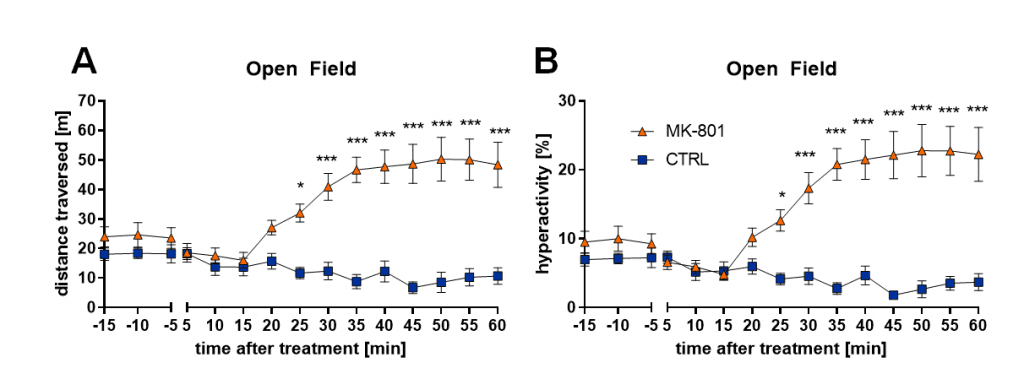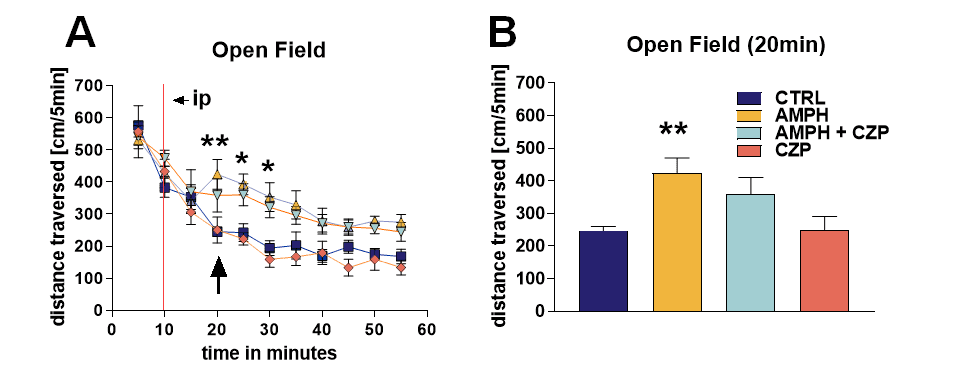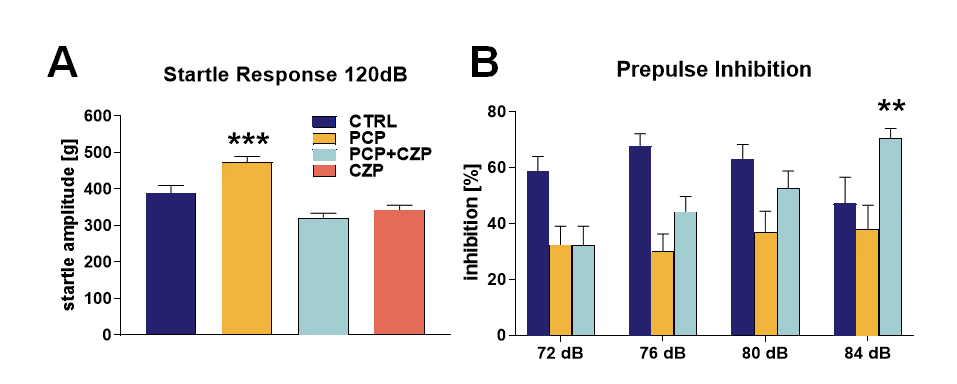MK-801-Induced Schizophrenia
Non-competitive NMDA receptor antagonists, such as MK-801, have been shown to produce complex symptoms that mimic the positive and negative indications, as well as the cognitive deficits, of schizophrenia patients. MK-801 (hydrogen maleate) impairs learning and memory functions that depend on the hippocampus and the amygdala. MK-801 also produces various effects on rodent behavior, including deficits in sensory processing, hyperactivity, stereotypy, and ataxia. Antipsychotic drugs, such as clozapine, used in the treatment of schizophrenia, have been shown to improve MK-801-induced cognitive impairment in mice.
The most important characteristics of MK-801-lesioned mice are:
- Hyperactivity
- Cognitive impairments
C57Bl/6 mice were injected with MK-801 and immediately analyzed in the open field test. Results show a strong increase in the distance traversed (Figure 1A) and time spent hyperactive (Figure 1B) starting 25 minutes after MK-801 treatment.

Figure 1: Open field test. A: Distance traversed of MK-801-treated animals compared to sham-treated controls (CTRL) B: Hyperactivity level of MK-801-treated mice compared to sham-treated controls. Mean ± SEM; two-way ANOVA with Bonferroni’s post hoc test. *p<0.05; ***p<0.001.
MK-801-injected mice are therefore a suitable model to study schizophrenia-like symptoms in vivo.
Amphetamine (AMPH)- or Phencyclidine (PCP)-Induced Schizophrenia
The most widely used animal models of the positive, negative, and cognitive symptoms of schizophrenia involve administration of the dopamine-releasing drug, d-amphetamine, in combination with the benzodiazepine chlordiazepoxide (AMPH) or an open channel NMDA receptor blocker, phencyclidine (PCP). Pretreatment with clozapine (CZP) can reverse the observed effects.
The most important characteristics of d-amphetamine-lesioned rats are:
- Increased activity in the open field test 10 minutes after treatment
- CZP reverses the effect of AMPH treatment
Rats were injected with AMPH and immediately analyzed in the open field test. Results show a strong increase in the distance traversed over time (Figure 2A), with the most significant difference observed at the 20 min timepoint (Figure 2B), which is reversible by CZP treatment (Figure 2 A, B).

Figure 2: Open field behavior of amphetamine (AMPH)-treated Sprague Dawley rats. A: Distance traversed in cm/5 min over time; mean ± SEM. two-way repeated measurements ANOVA with Bonferroni‘s post hoc test. B: Distance traversed in cm/5 min, 10 minutes after treatment; mean + SEM one-way ANOVA with Bonferroni‘s post hoc test.. CTRL = Control; CTRL, AMPH, AMPH+CZP: n = 8-10 per group; *p<0.05; **p<0.01.
The most important characteristics of phencyclidine-lesioned rats are:
- Increased startle response
- Decreased prepulse inhibition
- CZP can serve as reference compound for both tests
Rats were injected with PCP and analyzed in the startle response and prepulse inhibition test. Results show a strong increase in the startle amplitude after treatment with PCP that is reversible by CZP treatment (Figure 3A). Measurement of prepulse inhibition showed a minor but not significant decrease after PCP treatment that was significantly reversed after additional CZP treatment (Figure 3B).

Figure 3: Startle response and prepulse inhibition of PCP-treated Sprague Dawley rats. A: Startle amplitude in gram of PCP-, PCP+CZP- or CZP-treated animals at 120 dB; one-way ANOVA with Bonferroni‘s post hoc test. B: Prepulse inhibition in percent of vehicle-, PCP- or PCP+CZP-treated animals using 4 different dB intensities; two-way ANOVA with Bonferroni‘s post hoc test. A, B: n = 10; Mean + SEM; **p<0.01; ***p<0.001.
AMPH- and PCP-injected rats thus model schizophrenia-like symptoms in vivo.
Scantox offers a custom-tailored study design for all induced Schizophrenia models, and we are flexible to accommodate to your special interest. We are also happy to advise you and propose study designs. All induced models show a relevant Schizophrenia phenotype shortly after treatment. This grants a remarkable fast processing time of your Schizophrenia study. Furthermore, vehicle-injected mice or rats can serve as control needed for proper study design.
We are happy to evaluate the efficacy of your compound in these induced Schizophrenia animal models! The most common readouts depend on the model and include:
- Hyperactivity
- Cognitive deficits
- Increased Startle Response
- Decreased Prepulse Inhibition
